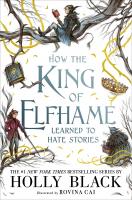
How the King of Elfhame Learned to Hate Stories is a companion book to Holly Black’s Folk of the Air series, this time following High King Cardan, one of the series’ more compelling characters. The timeline of this book spans from events before The Cruel Prince to events occurring after The Queen of Nothing, so it’s necessary to read all three books in the series in order to understand the events of this book (and avoid spoilers, of course).
Off the bat, this book stands apart from the rest of the series. Not quite hitting 200 pages, the book is significantly shorter than the main three books. It’s also illustrated, which might not appeal to all readers but lends it the feel of a book of fairytales. The book is also structured differently; instead of telling a chronological story, the book is made up of short chapters (prefaced by illustrated frontpages) that function as vignettes, showing what may first seem to be unconnected episodes in Cardan’s life.
The vignette format means there are large chronological skips in the plot; the first chapter takes place after The Queen of Nothing but is followed by a chapter that takes place when Cardan is a child, significantly before the events of The Cruel Prince. The timeline continues to skip forward until it eventually catches up to “real time,” or the events of the first chapter.
Readers who are looking for whole chapters from the series retold from Cardan’s point of view will inevitably be let down; this isn’t that kind of companion book. Instead, Holly Black sends Cardan on his own journey, one that intersects with Jude’s along the way, but is still undeniably Cardan’s. Even a reader unfamiliar with Black’s writing or the Folk of the Air series would be able to surmise that this book is intended to serve as a fairytale of sorts simply from the title, and the book does not disappoint on that front.
Aside from the obvious use of fairies as subject matter and the previously mentioned illustrations (done by award-winning Australian illustrator Rovina Cai), this book includes a repeating fairytale within a fairytale, a neat device that successfully parallels Cardan’s growth as a character throughout this book and the Folk of the Air series as a whole.
The story-within-a-story device is immediately reminiscent of J.K. Rowling’s "Tale of the Three Brothers" in Harry Potter and the Deathly Hallows, but Black takes her mini-fairytale farther, using it as a framework to connect what would otherwise be a very disjointed compilation of stories, and she also modifies it to suit different parts of the story and Cardan’s evolution. The mini story repeats three times: once at the beginning, once toward the middle, and the last occurrence during the climax of the plot, which is the most unexpected yet satisfying rendition of the three.
The plot itself is difficult to grasp hold of until about chapter 10, which is a long time considering the book only has 11 chapters. The first chapter, however, sets the scene for later in the book, and it’s evident throughout that the vignettes are building towards an event that won’t be revealed until the end. This book is not about plot; it’s not about telling a story with a clear, definitive series of chain-reaction events leading to an ultimate climax and resolution. Rather, it’s about the journey of self-awareness Cardan embarks on before and throughout the Folk of the Air series that allows him to be a redeemable and multi-faceted character in his own right.
Ultimately, this book serves its purpose; it’s a companion book to an existing series and would be unable to stand alone. It goes beyond that, however, in giving the reader such an intimate portrait of a pivotal character that the Folk of the Air series arguably can’t stand alone without it. After reading this book, it’s impossible not to use it to contextualize Cardan in the main series, and it adds such depth to the world and his character that it can’t be missed.
